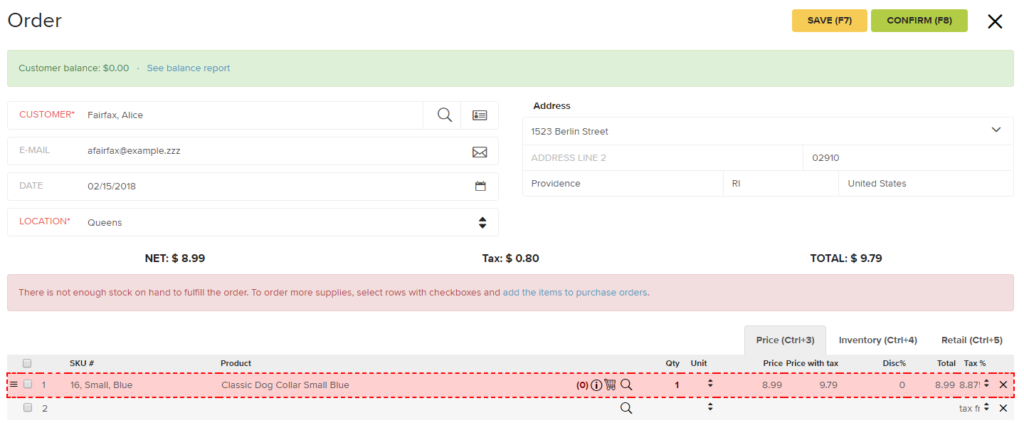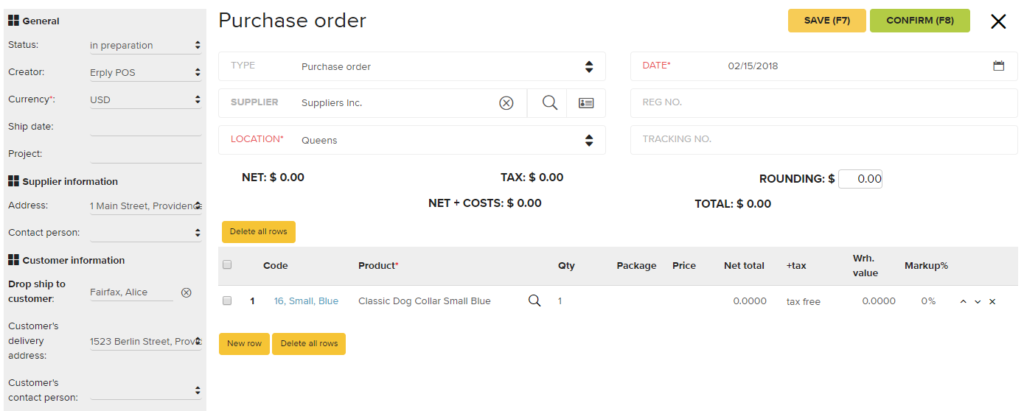But if your store is located in New York, and you get an online order from a customer in Oregon, how can you ensure that you get your product to them quickly without having to eat a huge shipping cost? The answer, as many businesses are learning, is a practice called drop shipping. But what is drop shipping, and should you use it for your business?
What is Drop Shipping?
Drop shipping is the practice of shipping products to buyers directly from the third-party manufacturer or wholesaler. You, as the merchandiser, will never actually see or handle the product. Instead, when a customer places an order with you, your system will automatically order the product from the location nearest to the consumer that has the product, so that it can be shipped to them much faster. Through drop shipping, some retailers don’t even have to carry merchandise anymore. Instead, their entire business model is based on being the middleman between consumers and the third-party wholesaler or manufacturer. This is one way to keep overhead costs very low while still operating a lucrative retail business – and while competing with the super-fast shipping of industry giants like Amazon.
Pros of Drop Shipping
Deciding whether you should use drop shipping for your business, whether entirely or just for some of your orders, takes some consideration. There are pros and cons to the system. The pros of drop shipping include:You don’t need as much capital because you aren’t buying and storing inventory before it is sold. Instead, you are directing revenue to the cost of inventory as it is needed.
It is easy and affordable to get a business off the ground with this method. You don’t have to have a physical location, inventory, handling returns, packing orders, managing your inventory levels, and all those other complex duties that are required of traditional retailers. So long as you have connections to manufacturers or wholesalers, and the ability to funnel money from orders to those manufacturers quickly, you have everything you need to get started. The most start-up capital you’ll need may be to start a website and pay for any legal fees necessary to own a business.
You can work from anywhere. Because you don’t have to have anything more than an Internet connection, you don’t have to worry about where you are to keep your company running. This means you can take vacations without shutting down your company, you can move when and where you want, you can continue working in another career, you can go to school – or you can simply choose to schedule your life in a way that works for you while still operating your company.
You can easily add a wider product selection and scale up your business. When you use a drop shipping method to operate a retail business, it’s very simple to increase your product selection, simply by getting in touch with a new supplier and then adding a new product to your online store. Scaling is quite easy as well. If your sales start to go through the roof, you don’t typically need to hire more employees or open new stores – you may just need to contact bigger suppliers or find more suppliers in more parts of the country to work with.
Cons of Drop Shipping
All the great things about drop shipping do come with some negative aspects to consider. Drop shipping doesn’t offer huge profit margins. Because there is such a huge and competitive market for good shipped quickly online, drop shipping retailers charge next to nothing for products. Without the overhead costs, they can afford to cut their prices, and that means that you’ll have to compete with their very low prices if you want to keep your customers around.
You can’t really offer quality control. When you stock your own products, you can ensure that products are in stock before you sell them, and you can ensure that your products are meeting a specific standard of quality. When you ship through a third party, there may be miscommunications about what is in stock, and you never get the chance to inspect products yourself. That can lead to poor customer experiences if you aren’t careful about which suppliers you work with.
Your brand is being represented by someone else’s work. When you have a third party shipping goods to your customers, you have to be willing to stake your brand’s reputation on that third party. Your customers will see their shoddy packaging, mistakes, shipping prices, and customer service as a direct reflection of you – because all they know is that they bought a product from you. This can be a very big concern, and it’s one of the main reasons why so many brands are still hesitant to embrace this model of business.
How to Make Drop Shipping Work for You
If you’ve read the pros and cons above, and you still think that drop shipping sounds like it could be a great way to build your business, then you’ve probably noticed that the biggest cons boil down to one thing: your supplier. If you are careful to choose the right suppliers, then you can eliminate most of the negative aspects of drop shipping. But finding great suppliers, with a commitment to quality and a regular supply of your most popular products, can be a challenge. Here are a few tips for making this business model work for you:
Look for local suppliers first. This is the best way to manage quality control because if your suppliers are local, at least you can keep in touch with them easier. It’s far easier to straighten out problems with a company that operates in the same time zone as you, than a company overseas. And if you can find a supplier in the same state or city, even better – then you may be able to inspect the product yourself. Don’t write off local wholesalers if they don’t currently do drop shipping. If you offer them a profitable deal, they may be willing to get in the game with you.
Look for reviews of online suppliers. There are many online wholesalers and manufacturers that specifically cater to drop shipping retailers. Once you’ve identified your retail niche, you’ll likely discover that there are one or two main supplier names in your niche that most of your competitors work with. Be sure that you research these popular suppliers carefully, looking for anything on Yelp or other review sites that raise red flags. Consider any information you can find about their fees, minimum order sizes, and other policies.
Depending on your niche, creating a list of anywhere between one and five suppliers to start with is a great first step. This allows you to narrow down your focus at the beginning on the suppliers that offer the most inventory with the most reasonable policies, and then build from there. If you can, try to make one to three of those on the list local suppliers.
How to Make a Drop Shipping Business Successful
If you take a look at all of the information above, you will see that we’ve primarily described being a drop shipping company as being a middleman, between the consumer and the supplier. The problem is that every other drop shipper out there offers the exact same service, and often with the exact same products from the same suppliers with the same shipping times. How can you make your business successful when the base idea is nowhere near original?Just like in all business, you have to stop focusing on what it is you’re doing for the customer, and focus on why you’re doing it – in other words, what problem are you solving for them? What value do you specifically bring to them through the sale of these products?
Maybe it’s that your drop supply business focuses on selling products that are customizable, which offers customers something unique and solves a desire to have custom-decorated items. Maybe your company focuses on a very specific ideal customer profile. For example, you might sell home repair tools just like hundreds of other companies out there – but perhaps your company builds its brand around selling home repair tools for first-time millennial homeowners. In that case, you’d want to focus on stocking high-tech repair tools and building your social media presence.
The next thing you need to do to make a drop shipping company successful is to focus on building a great website. As the only tangible thing about your business that exists (considering your products aren’t in a warehouse or a store you own), your website needs to be everything a brick and mortar store would be. It should be inviting, educational, useful, attractive, and evoke whatever emotional reaction it is that you want from your customers.
Remember that your website may also be a place where your suppliers contact you, so be sure there is an area specifically for managing that communication as well. E-commerce websites aren’t that hard to create these days thanks to templates and DIY design helpers like Shopify but do keep in mind that for the consumer, usability, and security are the two most important things. Your website must be easy to navigate on any type of device, and customers must feel comfortable putting their payment details on your website.
Is Drop Shipping Right for You?
Overall, drop shipping can be anything from an entire stand-alone business model, to a great way for a traditional retailer to expand their product line and reach. Determining whether you should use drop shipping takes understanding the needs of your customers. Do you frequently get orders from locations that are far away? Have you had complaints about your shipping speeds or the variety of your inventory? Do you want to expand into a specific niche, but want to test the waters first to see how it does before you sink a lot of capital into the new product line?If any of those sound like you, then drop shipping could be a great way to meet your needs. So long as you are careful to work with the right suppliers, and you consider how it is you are adding value to your customers’ lives, then you can make drop shipping very lucrative for your business.
However, don’t go into drop shipping expecting to make millions soon. The profit margins are low and the competition is very high. It will take time and the right network of suppliers to make your name a go-to in the online retail world.
How Your POS Can Help
Even if you have a drop shipping business, Erply can help you manage your orders and keep your business organized. If you have a sales order that will be drop shipped from a supplier to a client, you can still create the necessary paper trail in the system. Instead of removing inventory from the management system, Erply will create a purchase invoice that will automatically direct you to order the product from the supplier. In the ordering page, the customer’s shipping information will be filled in, so that it’s a much more streamlined process for you.
When you create a sales order with Erply, the system will alert you if any items on the order are out of stock and prompt you to create a purchase order for those items.

When you create the purchase order, you can choose to have the items drop-shipped directly to the customer.